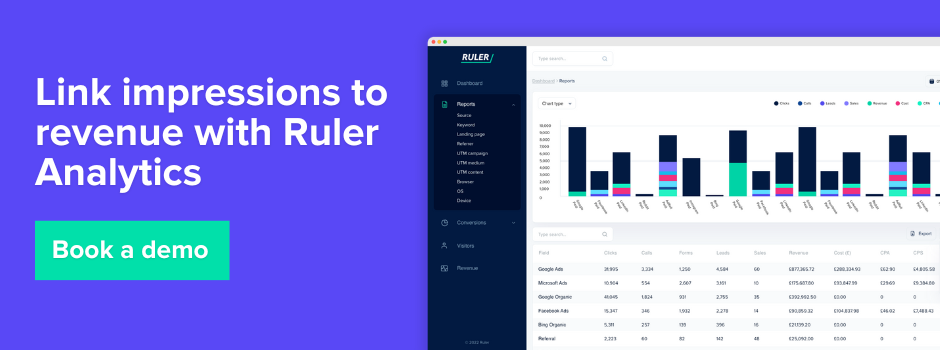Use impression attribution to measure the impact of your marketing and its contribution to revenue.
As the third-party cookie crumbles, evidencing marketing effectiveness has become a daunting puzzle for marketers.
Programmatic platforms like Meta and Google Ads, once reliant on these cookies to track conversions back to initial ad impressions, are now facing blind spots.
Further complicating this challenge, consumer behaviour is evolving – gone are the days of solely click-driven conversions. Today, consumers often view ads and convert later, leaving valuable interactions untracked and budgets misallocated.
Given this change in privacy policy and consumer behaviour, the spotlight turns to impression attribution as the key to revealing the hidden value of impressions and getting a complete view of marketing effectiveness.
Keep reading to learn:
💡 Pro Tip
Ruler breaks free from traditional click-based attribution. It uses a sophisticated machine-learning model that recognises the true impact of both click-path data and ad impressions. Leveraging a Bayesian statistical model and Shapley Regression, Ruler unlocks the previously hidden influence of ad views, connecting them to revenue outcomes–even in the absence of clicks.
Jump to the part about Ruler’s impression attribution, or book a demo to see how it can improve the quality of your marketing reports.
Impression attribution delves into the unseen influence of impressions, attributing conversions (like purchases or leads) and revenue to users who viewed your ad but didn’t click.
Imagine a user seeing your ad, not clicking, but later converting directly through your website.
Traditional analytics would miss this connection, attributing the conversion to organic and direct channels.
Impression attribution bridges this gap, acknowledging the influence of ad impressions in driving desired actions.
By tracking these often-invisible touchpoints through impression attribution, you can:
Impression attribution tracking emerges as a crucial tool for the future of measurement, offering three key benefits:
Third-party cookies, once the workhorse of ad tracking and measurement, are being phased out due to privacy concerns.
Related: How to prepare for the death of third-party cookies
This, coupled with the privacy restrictions introduced by iOS 14.5, has limited our ability to track user journeys across platforms, leaving in-platform attribution models incomplete.
As we bid farewell to third-party cookies, we’ll also be parting ways with view-through metrics in ad platforms.
Tools like Meta rely on third-party cookies to track users across websites, connecting ad impressions to eventual conversions. Without them, this cross-site tracking becomes cumbersome, making it harder to understand the impact of ad impressions.
However, not everything is at a loss. Even without third-party cookies and the restrictions set by Apple and Google, solutions like impression attribution can continue to connect ad impressions to conversions and revenue.
Through machine learning, it analyses website traffic fluctuations to uncover how your ads impact conversions and revenue, even weeks after an ad is seen.
Let’s get real for one minute. Third-party cookies or not, view-through metrics were never reliable.
Platforms like Meta use a 1-day window for attributing conversions to ad views. But let’s face it, buying decisions rarely happen in 24 hours.
Related: Facebook’s attribution settings explained
This narrow window creates a blind spot, undervaluing the crucial role display advertising plays in building demand generation and driving long-term sales.
Imagine the frustration:
You run a highly-engaged campaign. People see it, interact with it, but the purchase happens a few days later, outside the limited view through attribution window.

That conversion goes unaccounted for, likely misattributed to organic search or direct, leaving a false impression that your brand awareness efforts are ineffective. This disconnect throws off your budget allocation, potentially leading to missed opportunities.
Impression attribution gets this. It recognises the value of every impression, regardless of clicks or immediate conversions, acknowledging that brand awareness builds over time, leading to purchases days, weeks or even months later.
Chances are you’re using some form of click attribution and self-reported conversions to measure your marketing.
If you’re not, you should be.
Related: A complete guide to multi-touch attribution
Click attribution tracks click path journeys, assigning credit to each touchpoint or interaction leading to a conversion or desired outcome.
Self-reported attribution, often done through ‘how did you hear about us’ fields in forms and surveys, helps understand user motivations and tracks difficult-to-measure channels like dark social.
But understanding the full impact of your marketing goes beyond just clicks and surveys. While deterministic click attribution reveals conversion paths and self-reported surveys offer insights into user motivations, they leave a crucial gap: the power of ad impressions.
This is where impression attribution comes in. It bridges the gap between click-driven data and self-reported feedback, providing a missing piece to your marketing measurement puzzle by allowing you to understand how ad impressions influence user journeys and revenue.
Previously, we discussed how impressions on platforms like Meta, YouTube Ads and TikTok don’t directly translate into website visits, making it difficult to assess the true impact of upper-funnel campaigns.
In an ideal scenario, access to user-level engagement data from these platforms (e.g., video views and ad impressions) would provide greater clarity. However, privacy restrictions and regulations limit such data sharing.
What we do have is access to aggregated data, such as video views and impressions on campaign, device or origin level and AI machine learning.
Using tools like Ruler’s impression attribution helps link these metrics and upper-funnel channels to revenue, giving us a clearer view of campaign effectiveness.
Applying a machine learning-based Bayesian statistics model, Ruler develops sophisticated algorithms to match impressions to eventual conversions and revenue.
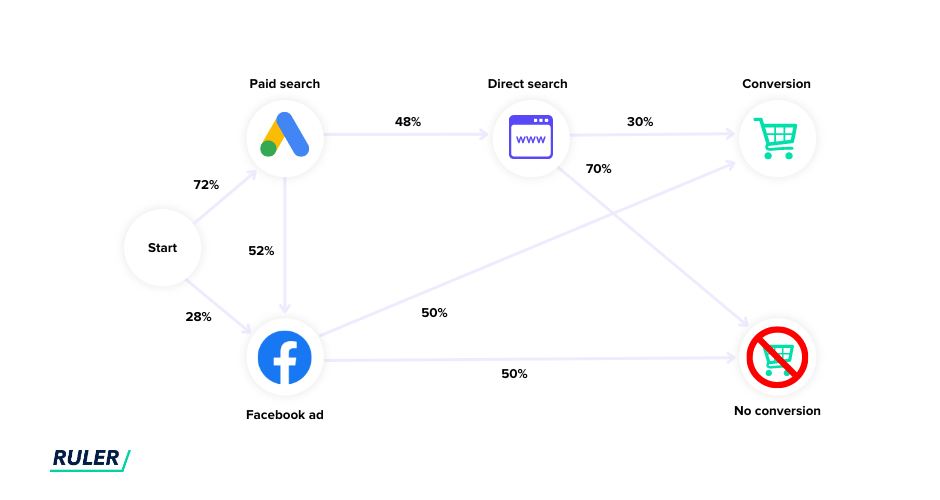
In cases where robust models like MMM (marketing mix modelling) are available, Ruler integrates their outputs to weigh channel contributions. In cases where MMM data is absent, Ruler uses click-through rates, impression volumes, and other user-level signals.
Once impressions are matched to conversions, Ruler utilises Shapley Regression to distribute credit.
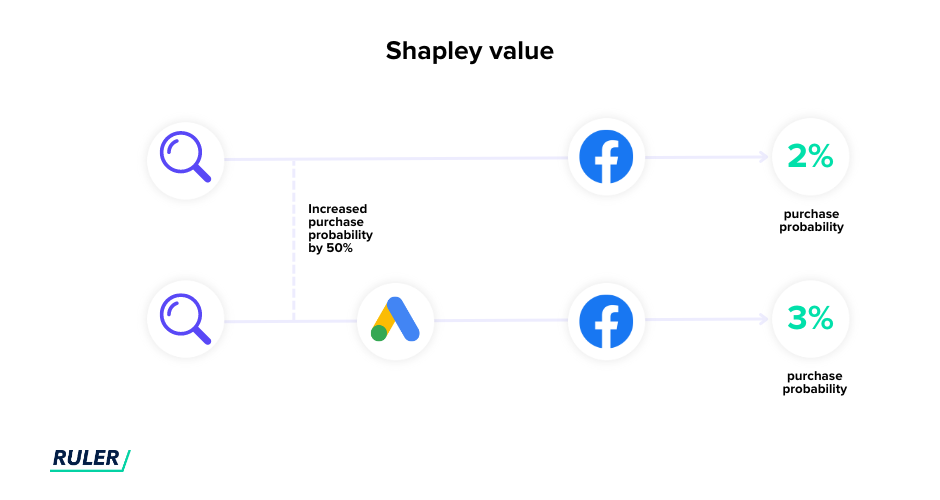
Here’s an example scenario to demonstrate its value:
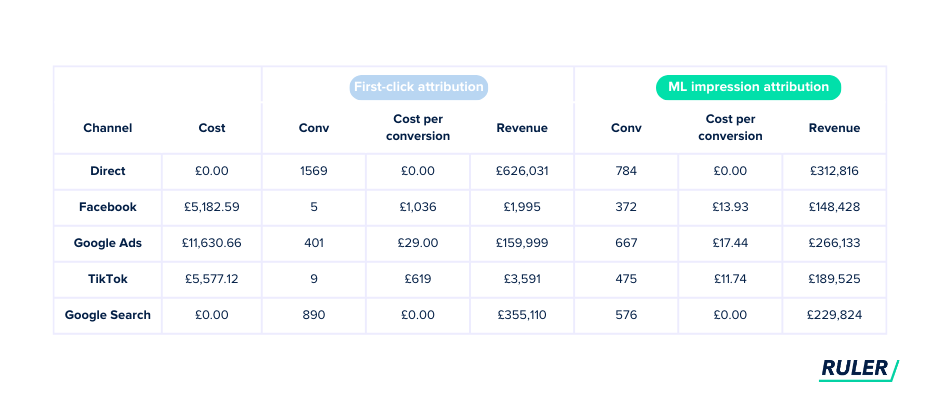
This example shows a roll-up marketing source report for the previous month. Both TikTok and Facebook received roughly the same investment during this period.
Focusing solely on first click-attribution reveals that the “Direct” source generated the highest number of conversions and revenue, while TikTok and Facebook seemingly contributed minimally.
Based solely on this analysis, these results would suggest a high cost-per-acquisition and low return on ad spend for TikTok and Facebook campaigns, potentially leading to the erroneous decision to discontinue them.
However, employing an impression-based attribution model presents a significantly different perspective.
This model redistributes conversions and revenue across all channels, including TikTok and Facebook, acknowledging their influence in generating conversions and revenue.
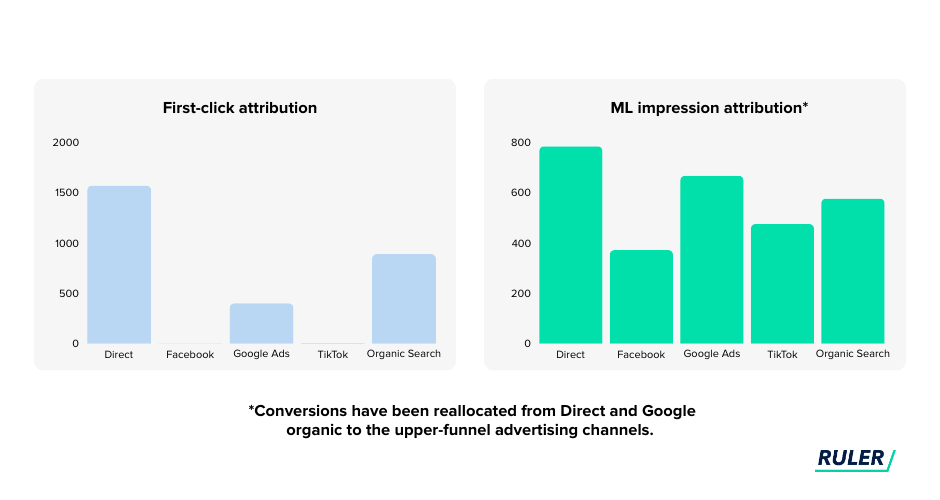
Maintaining deterministic click attribution is crucial as it reveals user interactions throughout their click-path journey.
However, impression attribution offers a different perspective by illustrating how non-click interactions contribute to revenue, preventing the premature dismissal of upper-funnel channels that may prove effective.
In fact, one of our customers experienced a 40% drop in direct traffic conversions after implementing impression attribution.
Impression tracking isn’t just another fad.
It’s the future of unlocking invisible touchpoints and proving ROI in a world without third-party cookies and stricter data privacy policies.
Remember, click attribution still has its place in marketing measurement. It unveils the path to conversion through clicks and identifies the pages, content, ads, and campaigns that drive interest.
But if you’re tired of wrestling with the ever-present struggle to show the value of your upper funnel efforts, it’s time to unlock the power of impression attribution.
See how Ruler can help you validate those brand awareness campaigns, reclaim “direct” traffic conversions, and optimise your marketing spend for maximum revenue by booking a demo today.
